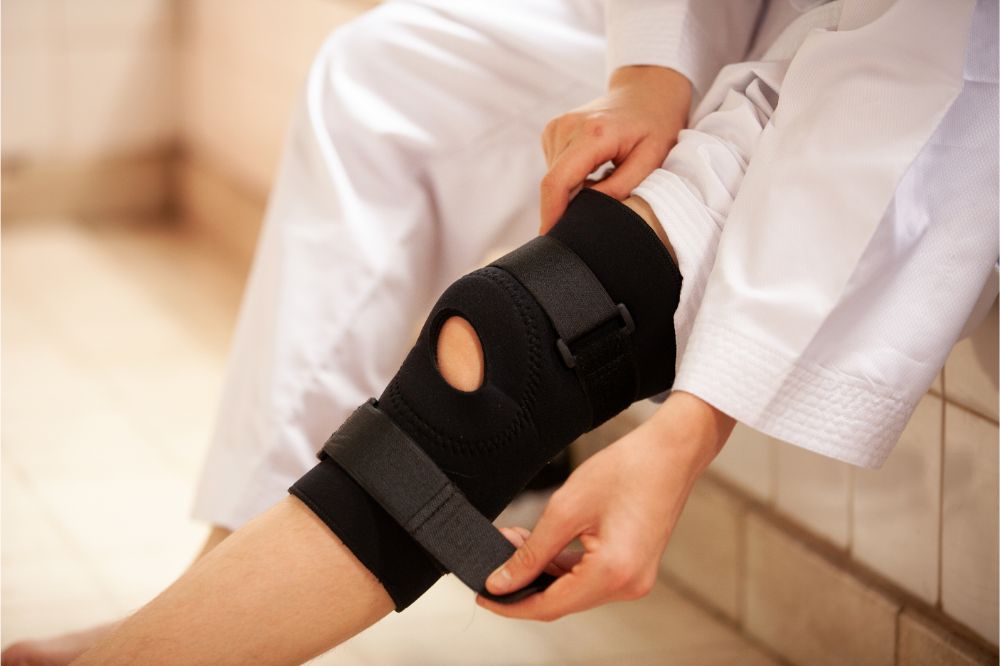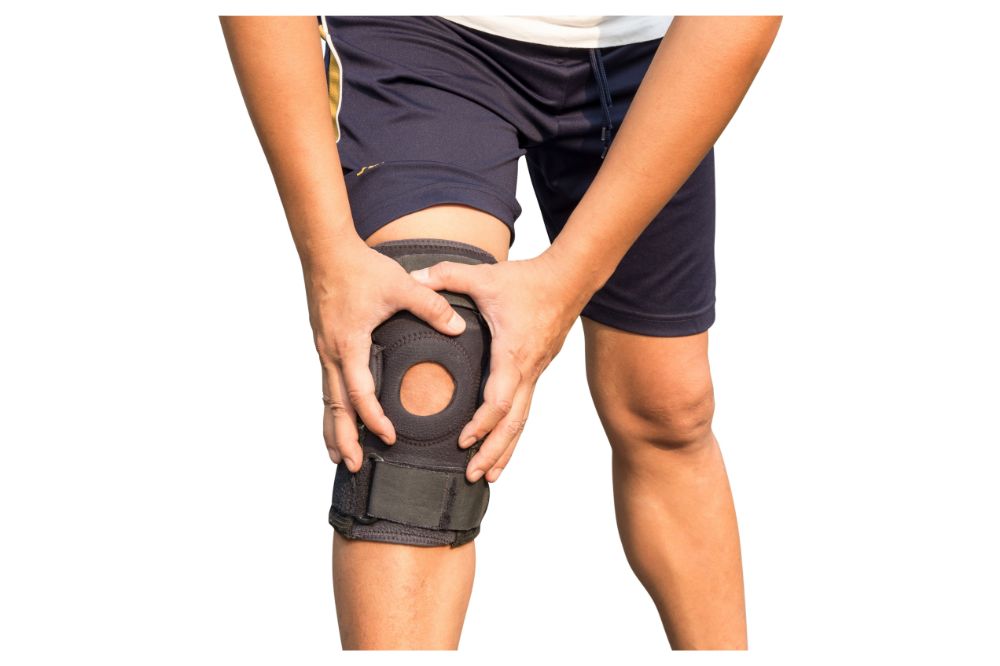When you go to the doctor for a knee injury, there is a good chance that a physical therapist will recommend that you wear a knee brace.
This tool helps rehabilitate your knee joint, reduce pain, and prevent even more damage.
However, only a few people know when they can remove them.
So, if you’ve ever asked, “How long should I wear a knee brace?” we’ve got definitive answers for you below.

How Long Should I Wear a Knee Brace?
When you asking, “How long should I wear a knee brace?” you should also ask, “What type of injury do I have? How severe is the injury? How long does it take to heal?”
It’s important to note that different knee issues also have different recovery periods. It’s just like a wound; deeper wounds take longer to heal, while shallow ones heal quicker.
It is best to consult a physical therapist to determine an effective treatment plan.
To give you an idea, here’s a rough estimate of how long you should wear your knee brace according to your injury:
ACL Injuries
ACL stands for anterior cruciate ligament. It is one of the most important ligaments in your knee that is primarily responsible for stabilization.
It also connects your thigh bone or femur to your shin bone or tibia.
Unfortunately, because of its huge responsibility, it’s also prone to tearing. This is very common when conducting athletic activities.
It’s also one of the most common injuries in contact sports.
An ACL injury may occur when the person overstretches the leg or lands in the wrong position after a jump. This can cause intense knee pain.
In worse cases, an ACL injury may end an athlete’s career.
First Degree Tear
Despite what the name suggests, a first-degree ACL tear is technically not a “tear.”
It can still cause mild pain, but there are no torn ligaments in this type of injury. Instead, it’s overstretched.
There might be a bit of joint stiffness and swelling, but you’d still be able to walk and conduct low-impact activities.
In these cases, you may only be required to wear a knee brace for four to six weeks.
Second Degree Tear
In a second-degree tear, the knee damage is a bit worse.
The ACL is not completely torn, but the slight tear can still cause a swollen knee, tenderness, and moderate pain.
You may still be able to walk. However, you will experience considerable pain in your knees when you bend and extend your legs. You may also limp while walking.
For a second-degree ACL tear, a bone doctor may recommend that you wear a knee brace for six to eight weeks and refrain from high-level activities.
Third Degree Tear
A third-degree tear is the worst type of ACL injury. In these cases, the ACL is completely torn apart, and you will need a surgical procedure to reattach the knee ligaments.
You will feel extreme pain and tremendous swelling in your knees.
Your doctor will recommend wearing a knee brace post-ACL reconstruction for eight to 10 weeks after the surgery.
You might also have to stay away from heavy physical activities for months and only stick to rehabilitative exercises.
Torn Meniscus
If the ACL attaches the upper leg bone to the lower leg bone, the meniscus functions as a cushion between these two.
Instead of overstretching, the primary cause of a torn meniscus is sudden harmful movements and twists, especially while carrying a heavy load.
There are about half a dozen types of meniscus tears, with some of them requiring knee surgery.
That said, the meniscus heals considerably faster than the ACL.
For this type of injury, you may only need to wear a knee brace or a knee immobilizer for six weeks or until the meniscus fully heals.
It’s also a great idea to wear knee braces designed specifically for meniscus tears, like the Gonairey Decompression Knee Brace for faster recovery.
Which Knee Brace Should I Use?
Aside from knowing how long you should wear them, you should also learn the different types of knee braces. This will help you determine which one you need for your injury.
Here are the most common types of knee support products and what they provide you with:
Knee Sleeves
A basic knee sleeve is made of elastic material that slides over the knee. It may include little padding and a small opening for the kneecap.
The basic purpose of this type of sleeve is to keep the knee warm and reduce swelling.
The additional padding may also protect the knee from minor bumps and other elements. They may also provide mild support for knee arthritis.
However, you must keep in mind that these are not rehabilitative braces. They aren’t used to support the knee after surgery or an injury.
You can wear a compression knee sleeve anytime you want and take them off accordingly.

Knee Pads
A knee pad is almost like a compression sleeve, except that it has rigid outer shells and extra thick padding. Additionally, knee pads include straps so that they better fit your knees.
Just like knee compression sleeves, knee pads aren’t rehabilitative braces and do not increase your stability.
However, athletes commonly use them because they significantly reduce the risk of injuries and bruises.
You can wear these whenever you’re playing contact sports or doing continuous activities. You can take them off as soon as you’re done with whatever you were doing.
Patellar Tracking Orthosis Brace
The patellar tracking orthosis brace or PTO brace focuses mainly on the kneecap, hence the name “patellar.”
Another common knee injury is patellar dislocation or subluxation. It occurs when the kneecap is dislodged from its original location because of blunt force or overstretching.
The PTO brace includes a rigid opening combined with straps or buttressing, like the one you see in the Neenca Patella Knee Brace.
You then have to ensure that your kneecap is right within the opening of the brace.
After doing so, you can adjust the tightness of the opening using the straps. It keeps your kneecap in place even during physical activities.
Some also experience pain from patellar dislocation, and the PTO brace provides pain relief in these instances.
However, you may want to put lotion on your knees, as the thick material may cause skin abrasion or irritation over time.
You can wear this type of brace until your patella is fully healed.
Hinged Knee Braces
A hinged knee brace is perhaps one of the most sophisticated knee injury products.
Unlike sleeves or pads, this type of knee brace includes two bars on each side. The bars have hinges and straps that hold the knee brace in place.
There are multiple types of hinged knee braces, but they all support the ligaments of your knees.
With a hinged knee brace, you can limit the range of motion of your knees. You can set how much you can bend or extend them, so you don’t harm yourself further.
Hinged knee braces are vital to your healing. That’s why doctors recommend that you wear them as much as you can.
That’s right. You might even be encouraged to wear a hinged knee brace while you’re asleep so as not to hurt yourself, especially if you move in your sleep.
Knee Immobilizer
A knee immobilizer is exactly what its name suggests. It keeps your knee in a fixed position, preventing you from bending or extending it.
This type of knee brace is almost exclusively used after knee injury surgery or severe injuries that don’t require surgery but need extensive care.
Depending on the severity of the injury, a doctor may recommend that you wear a knee immobilizer even when you go to bed.
This ensures you don’t damage the torn ligaments or tissues in your sleep. Just make sure you get a high-quality product for maximum results.
Check out the sophisticated Novrliy Hinged Knee Immobilizer if you’re planning to get one.
How Long To Wear a Knee Brace
To conclude, the question is not, “How long should I wear a knee brace?”
Instead, you should ask how long it takes for your knee injury to heal and how long it would need artificial support from your knee brace.
That said, you can never go wrong with asking your doctor or physical therapist what type of functional braces you can wear and for how long.
Also, remember that a proper diagnosis of your injury is necessary to determine the answers to these questions.